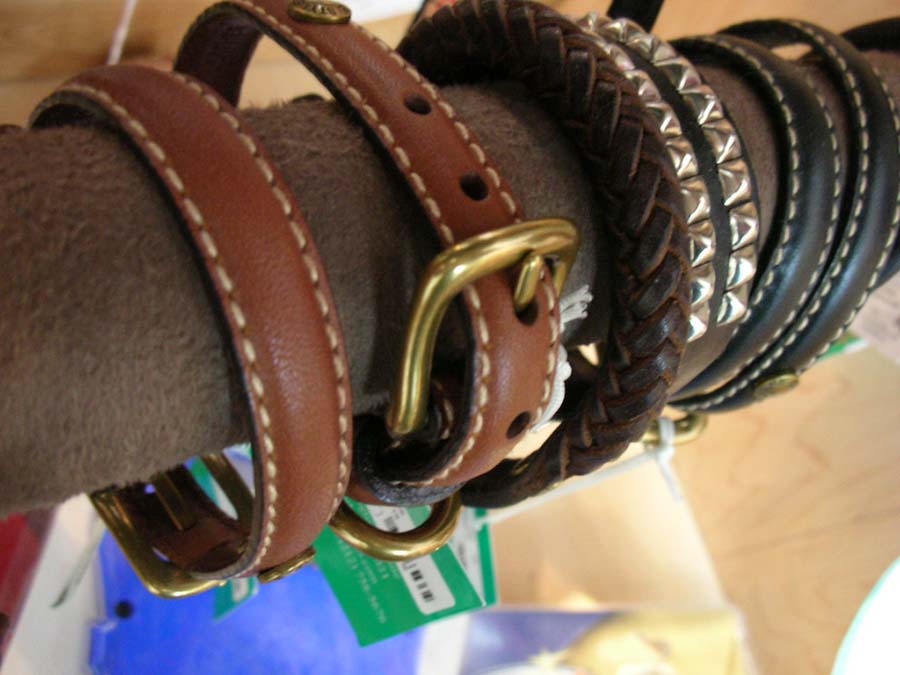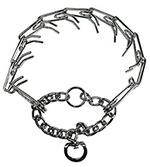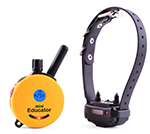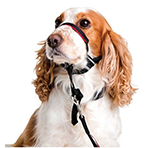
A dog training collar is one of the most important pieces of equipment you can pick for your dog.
Many people wonder about what kind of training collar they should get for their dog. The question becomes more important if your dog is a puller or is reactive towards people, vehicles, or other animals when out on walks.
Best Dog Training Collar for Your Dog
Flat Collars
 Flat collars come in a lot of colors and can be quite decorative. Most dogs should wear one with an id tag attached, even if you’re not hooking your leash to it.
Flat collars come in a lot of colors and can be quite decorative. Most dogs should wear one with an id tag attached, even if you’re not hooking your leash to it.
But if your dog pulls, a flat collar isn’t best for walking as it can put pressure on delicate areas in the neck, like the trachea. For most dogs, a harness or head collar is best.
Flat collars can get hung up on things, which is why some people don’t keep them on their dog. But if your dog is lost, even if microchipped, that lack of id may make it more difficult to get your dog back.
Thankfully, flat collars also come in breakaway styles so that if your dog did get hung up, the collar would break off. But if you’re using one for leash walking, make sure it won’t come undone if your dog pulls.
Prong and Choke Collars
 These collars work by inflicting pain or discomfort on your dog. Some trainers will try to persuade their clients that they’re no big deal and may even put it around your wrist to show you. But there are only 2 basic ways [1] we can influence a dog’s behavior:
These collars work by inflicting pain or discomfort on your dog. Some trainers will try to persuade their clients that they’re no big deal and may even put it around your wrist to show you. But there are only 2 basic ways [1] we can influence a dog’s behavior:
- reward what we like to get more of it
- punish what we don’t like
At worst these types of collars can damage the throat, neck, esophagus, and other delicate areas. At best, they are relying on annoyance and irritation. In between is fear, pain, and some use it to cut off a dog’s oxygen.
I recently watched a case study with a dog who was put on a prong, a trainer jerked, and the dog bit him. It turned out the dog had undiagnosed spine and neck issues. That leash jerk undoubtedly caused excruciating pain.
If your dog pulls or is reactive on walks, there are far better tools to keep you and your pup safe.
Shock Collars or E-Collars
 There are a few franchised dog training companies that provide these. They also seem to be popular with board and train companies, as well as other private trainers. The way they are explained is that they are like a “tap on the shoulder.” Or clients will be told that, “it’s just like a TENS unit.”
There are a few franchised dog training companies that provide these. They also seem to be popular with board and train companies, as well as other private trainers. The way they are explained is that they are like a “tap on the shoulder.” Or clients will be told that, “it’s just like a TENS unit.”
Similarly to the prong and choke chains, this type of collar cannot work without inflicting discomfort and pain. As a human, you can adjust your own TENS stimulation up or down so that it’s comfortable for you. Dogs are not given any choice in the matter and it’s not an apt comparison.
What a human is focused on when delivering a shock, is not necesssarily what the dog is focused on. There can also be fallout from the use of the collar. I have a friend who put her dog through rattlesnake avoidance training with a shock collar. The dog developed a phobia of lawn sprinklers (the sound was similar to the snake.)
Head Collars (or Head Halters)
 More about these in the section on leash pulling. Many people think these are some type of muzzle, but they are actually a type of collar.
More about these in the section on leash pulling. Many people think these are some type of muzzle, but they are actually a type of collar.
When a dog pulls, the head is gently turned back towards the handler. This is a safe and humane way to get a dog to not pull an owner around. There is more about them in the leash pulling section.
What Collar to Use for Leash Pulling
These punitive collars are often used by people whose dog pulls them around. No one enjoys being pulled and older people may actually be in danger of being knocked over if they’re walking a big dog that pulls hard. There are at least 3 ways to solve pulling problems, and 2 don’t even require training!
- Train your dog not to pull. There are many ways to use reward based training to get your dog to stop pulling. But, I encourage people to not bother and instead use either of the other options in this list.
- Head Collars. I’m aware of two brands: Halti and Gentle Leader. Both go around the snout. Many dogs are nervous or scared by these and those dogs will need counterconditioning to get them to accept them. But they are a humane and effective tool to stop pulling and can also be very helpful for leash reactive dogs.
- No Pull Harness. These harnesses work because the leash is clipped to the front of the chest. When the dog tries to pull, he ends up going a bit sideways. He soon figures out on his own, that to go where he wants to, he needs to keep pressure off ad not pull. These won’t work for every dog, but most pet stores would let you make a return if it’s not working for your particular dog. These are my favorite for pullers.
But My Dog Goes Crazy on Leash!
Dogs can be reactive on leash, pulling, snarling, lunging, growling at motor vehicles, bicycles, people and other dogs. This can be due to frustration, fear, or other emotions. Head collars can be a helpful tool along with desensitization and counter conditioning.
[1] There is so much more to this topic but I’m keeping it simple for our purposes.
If your dog has trouble walking nicely on a leash and you’re in the greater Sacramento area and need help, let’s talk!